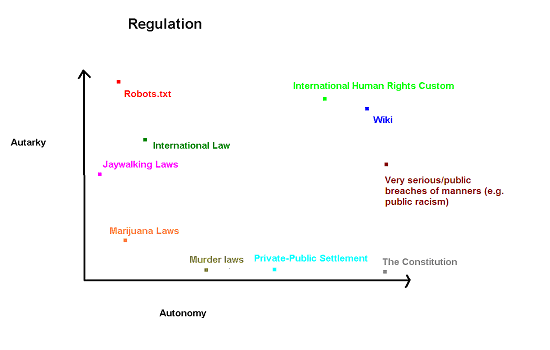David Siffert Thought Paper 2b
Given that I think JZâs top-down/bottom-up scale refers to norm creation, I argue that his hierarchy/polyarky distinction would be better conceived as a gage of norm enforcement. I then outline what I think the resulting graph would look like.
I have two complaints about the hierarchy-polyarky distinction. First, I think the competition aspect (toilet paper) is very different from the enforceable norm aspect (backlash to racism). I donât know how they both fit under one scale. Second, the âenforceable normâ aspect seems to look a lot like top-downness except for in certain situations, such as backlash against racism. To that extent, it is very similar to Wikipediaâs governance, which is clearly polyarchical (if not, what is, besides pure anarcho-libertarianismâeven most anarchists would be hierarchical).
What seems to be the main distinction between Wikipedia and social stigma is that the latter actually infringes on freedom to act via physical consequences. This is a limit to autarky. Top-down norm dictation, then, is a limit to autonomy/polyonomy (I do not distinguish between the two).
Now one can certainly divide enforcement into top-down and bottom-up enforcement. However, there are two reasons we shouldnât care too much. First, one can never really enforce things on oneself (unlike with norms), so all enforcement is somewhat top-down. Second, it does not seem clear that mob rule would be better or worse than organized sanction. We should acknowledge, though, that the more centralized the enforcement, the firmer the enforcement is likely to be, and the more it is likely to infringe on autarky. As such, I put publicly-enforced norms as moderate autarky.
Here is a pretty graph:
Note that laws are more autonomous if they are derived from preexisting norms and are more likely to be followed even without the law. Also note that the Constitution is an excellent example of a norm created by the people as a whole but enforced by the insulated elites rigidly on the population.
I argue that the move you describe to hierarchy from polyarky is mostly a downward shift in autarky, which is much more problematic than a leftward shift in autonomy. The former limits freedom to transact, which has deadweight efficiency costs as well as clear generativity costs. Furthermore, it can override existing inefficient social costs that prevent otherwise-efficient action (e.g. itâs considered unacceptable to purchase your friendâs bottle of water, even if you are thirstier than they).
The latter seems like a practical alternative due to perceived normative differences between effects of action and inaction. If we take the camera/RFID example and, instead of just a flashing âphoto not approvedâ light, we forced the user to take an affirmative step to override, they feel more responsible. If, in uploading the photo, they are forced to type âI am hurting someoneâs feelingsâ (the reason what they are doing violates a norm), we are likely to get substantial deterrent effect without market costs.
The upshot of using the graph my way is that it is practicalâusing hierarchy does not create clear prescriptions on how to regulate and where to look first. Should we try to eliminate competition? How would we go about trying to enforce norms from the bottom up? And how are the two similar? Using autonomy and autarky, we know first to look to government âsuggestions,â preferably with interesting moral ploys that deter conduct without inhibiting freedom or generativity. Next, the government can try to enforce the societal norms at play. Only if the problems persist should we resort to typical top-down legislation.
